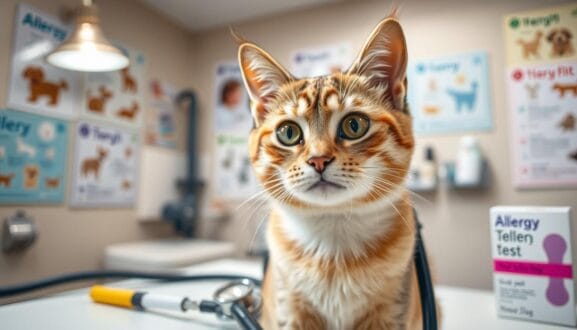As a pet owner, the thought of your cat having an allergic reaction is worrying. You may wonder, can cats be allergic to dogs? Knowing the signs of this allergy is key to keeping your pets healthy.
We’ll dive into why cats might react to dog allergens, the symptoms to look out for, and how to make a safe space for both pets. Being informed and taking action can help your pets live together happily, without allergies getting in the way.
- Understanding Pet Allergies: The Science Behind Feline Reactions
- Can Cats Be Allergic to Dogs?
- Key Physical Symptoms of Dog Allergies in Cats
- Behavioral Changes That Signal Pet Allergies
- How Dog Dander Affects Your Cat's Health
- Diagnosing Dog Allergies in Cats: Veterinary Approaches
- Treatment Options for Cat-Dog Allergies
- Creating a Safe Environment for Both Pets
- Preventive Measures and Management Strategies
- FAQ:
- What are the symptoms of cat allergy?
- What are cats most allergic to?
- Can dogs be allergic to cat food?
- Can I live with a cat if I'm allergic?
- Can a cat allergy go away?
- Are cats allergic to smells?
- How to cure a cat allergy?
- What are the common allergens in dogs that affect cats?
- How does the feline immune system respond to dog allergies?
- What are the key physical symptoms of dog allergies in cats?
- How do veterinarians diagnose dog allergies in cats?
- What are the treatment options for cat-dog allergies?
Understanding Pet Allergies: The Science Behind Feline Reactions
As a pet owner, you might have seen your cat act strangely around dogs. Cats can be allergic to things dogs have, like dander. Knowing about these allergies is key to keeping both pets healthy.
Common Allergens in Dogs That Affect Cats
Dogs can make allergens that bother cats. These include:
- Dog dander: Tiny flakes of skin shed by dogs that can contain proteins that cats may be sensitive to.
- Dog saliva: Proteins found in a dog’s saliva can cause allergic responses in some cats.
- Dog urine: Compounds in a dog’s urine can also be a source of allergens for feline companions.
How the Feline Immune System Responds
When a cat meets dog allergens, its immune system sees them as threats. It then fights back, releasing chemicals like histamine. This fight can make the cat very uncomfortable.
| Allergen | Potential Feline Reactions |
|---|---|
| Dog Dander | Respiratory issues, skin irritations, digestive problems |
| Dog Saliva | Skin rashes, hives, difficulty breathing |
| Dog Urine | Urinary tract infections, digestive distress |
Learning about these allergies helps pet owners make a safe space for both dogs and cats.
Can Cats Be Allergic to Dogs?
It might seem unlikely, but cats can indeed get allergies from dogs. This is known as pet cohabitation. It happens when a cat’s immune system reacts to dog allergens.
Cats have a sensitive immune system. They can react to dog dander, saliva, or proteins in urine. This can cause a range of symptoms in cats.
Factors Contributing to Cat-Dog Allergies
- Genetic predisposition: Some cats are more likely to get allergies, especially from dogs.
- Exposure level: How often and how long a cat is around a dog can affect allergies.
- Breed-specific sensitivities: Some cat breeds, like Siamese and Abyssinians, might be more likely to get dog allergies.
Not all cats will get allergies from dogs. It depends on the cat’s immune system and environment.
| Breed | Allergy Sensitivity |
|---|---|
| Siamese | High |
| Abyssinian | High |
| Persian | Moderate |
| Maine Coon | Low |
Knowing about can cats be allergic to dogs helps pet owners keep their pets happy together.
“Coexistence between cats and dogs requires vigilance and care to ensure the well-being of both pets.”
Key Physical Symptoms of Dog Allergies in Cats
Spotting dog allergies in cats is key for their health. Knowing the main symptoms helps you act fast to keep your cat happy and healthy. Here are the main signs to watch for:
Respiratory Issues and Breathing Problems
Cats with dog allergies might have trouble breathing. They might sneeze, cough, or have trouble breathing. This is because their airways get inflamed and irritated.
Watch how your cat breathes and for any odd sounds. These could mean they’re having an allergic reaction.
Skin Reactions and Irritations
Some cats with allergies show skin problems. They might itch a lot, get rashes, hives, or even lose fur. This is because their immune system overreacts to dog allergens.
Keep an eye on your cat’s skin and how they groom. This can help you spot any allergy issues early.
Digestive System Responses
Dog allergies can also upset a cat’s stomach. They might vomit, have diarrhea, or not want to eat. This is because their body tries to get rid of the allergens.
Knowing these signs helps you spot and treat dog allergies in cats. Watch your pet closely and talk to a vet. This way, you can keep your cat comfortable and healthy.
Behavioral Changes That Signal Pet Allergies
Watching your cat closely during cat and dog interactions can tell you a lot about their pet health. Some key signs might show that your cat is allergic to dogs.
One sign is a change in how active they are. An allergic cat might sleep a lot or seem tired. On the other hand, they might move a lot and seem uncomfortable.
Changes in how they act around others are also important. An allergic cat might pull away from the dog or even hiss. Some cats might want to be with their owners all the time.
Also, look at how they groom themselves. An allergic cat might lick or scratch too much, causing skin problems and hair loss. Watch for any unusual grooming habits.
By paying attention to your cat’s cat and dog interactions and overall pet health, you can spot signs of allergies. Recognizing these changes helps you take care of your cat’s comfort and health.
How Dog Dander Affects Your Cat’s Health
As a pet owner, you might know that animal dander can cause allergies in both humans and pets. It’s especially important to know how dog dander affects your cat’s health.
Understanding Dog Dander Composition
Dog dander is made up of tiny skin, fur, and saliva flakes from dogs. These tiny particles can carry allergens like proteins. These proteins can make sensitive cats react.
Transmission Methods and Exposure Risks
Dog dander can spread all over your home. It can get on clothes, furniture, and even in the air. Cats can get exposed to dog allergens by touching their dog friends or living in the same space. Being around these allergens for a long time can make your cat sick.
| Allergen | Source | Potential Health Risks |
|---|---|---|
| Dog Dander | Shed skin, fur, and saliva particles | Respiratory problems, skin irritation, digestive issues |
The table shows that dog dander can harm your cat’s breathing, skin, and stomach. It can cause many uncomfortable symptoms. Knowing the risks and taking steps to reduce your cat’s exposure is key.
“Understanding the composition and transmission of dog dander is the first step in protecting your cat’s health from potential allergens.”
Diagnosing Dog Allergies in Cats: Veterinary Approaches
If you think your cat might be allergic to your dog, getting help from a vet is key. Finding out if your cat has an allergy to dogs needs special care. Vets use many tools to figure out what’s causing your cat’s symptoms.
First, a vet will check your cat’s body for signs of trouble. They’ll look at the skin, eyes, ears, and breathing system. They might also ask about your cat’s behavior, food, and environment.
Testing for feline allergies is a big part of diagnosing. Vets can do skin or blood tests to find out if your cat is allergic. These tests show which allergens, like dog dander, are causing the problem.
At times, vets might suggest a special diet for your cat. This diet is free from common allergens. It helps find out what in your cat’s food might be causing the allergy.
It’s very important to work with your vet to find out if your cat has an allergy to dogs. Their knowledge and tests can help you understand your cat’s needs. This way, you can make your cat feel better and live a healthier life.

| Diagnostic Approach | Purpose |
|---|---|
| Physical Examination | Identify physical symptoms and signs of allergic reactions |
| Allergy Testing (Skin or Blood) | Detect specific antibodies and pinpoint the triggering allergens |
| Elimination Diet Trial | Isolate dietary triggers and identify food-related allergies |
Treatment Options for Cat-Dog Allergies
Dealing with pet allergies can be tough, but there are many ways to help your cat feel better. You can choose from medical treatments or natural remedies. Knowing what’s out there can really improve your cat’s life.
Medical Interventions and Solutions
If your cat has a bad allergic reaction to dogs, your vet can help. They might give your cat medicines like antihistamines. These can lessen symptoms like sneezing and itching.
In some cases, your vet might suggest immunotherapy. This means slowly introducing your cat to the allergen to build up a tolerance.
Natural Remedies and Alternative Treatments
There are also natural ways to help your cat with pet health issues. Omega-3 fatty acids can boost your cat’s immune system and reduce swelling. Also, special shampoos and conditioners can help by removing allergens from your cat’s fur.
Using a mix of medical and natural treatments can be the best way to manage feline allergies. It helps keep your cat healthy and happy, even when they live with other pets.
| Treatment Option | Description | Potential Benefits |
|---|---|---|
| Antihistamines | Prescription medications that reduce the body’s inflammatory response to allergens | Alleviate symptoms like sneezing, itching, and respiratory distress |
| Immunotherapy | Gradual exposure to the allergen to build tolerance and reduce sensitivity | Address the root cause of the allergy and provide long-term relief |
| Omega-3 Supplements | Natural anti-inflammatory compounds that support the immune system | Reduce inflammation and promote overall health |
| Hypoallergenic Grooming Products | Shampoos and conditioners designed to minimize exposure to allergens | Minimize the impact of pet cohabitation by reducing dander and allergens |
By looking into different treatments and talking to your vet, you can find a good plan. This plan will help manage your cat’s feline allergies. It will make sure your cat and dog can live together comfortably and healthily.
Creating a Safe Environment for Both Pets
Living with both cats and dogs can be a challenge. If your cat is allergic to your dog, it’s important to reduce animal dander and allergens in pets. This helps prevent any bad reactions.
Make sure to have “cat-only” areas in your home. Keep your dog out of these spots. This includes where your cat likes to rest, the litter box, and any high places they enjoy. These safe zones help keep your cat away from allergens your dog might bring.
- Use high-efficiency particulate air (HEPA) filters in your home to capture pet dander and improve air quality.
- Regularly groom your dog and vacuum thoroughly to remove loose hair and dander.
- Consider using pet-safe cleaning products that are designed to reduce allergens.
Also, think about getting:
An air purifier made for pet homes, or a robotic vacuum cleaner to clean floors and carpets. These steps can make your home healthier for both pets.
“The key is to find a balance that allows both pets to thrive, while also managing any allergy concerns.”
Every pet and home is different. You might want to experiment with some different things to find out which one really suits you. By being careful and focusing on your cat’s health, you can help both pets live together safely and happily.

Preventive Measures and Management Strategies
Keeping your home clean for both your cat and dog is key when dealing with allergies. By following cleaning tips and improving air quality, you can lower allergen exposure. This makes your home more comfortable for your pets.
Cleaning Tips and Air Quality Control
Regular vacuuming, dusting, and washing your pets’ bedding can help a lot. Use a vacuum with a HEPA filter to catch small particles. An air purifier can also improve your home’s air, trapping allergens and keeping your pets’ space clean.
Separation Techniques and Space Management
Managing allergies between your cat and dog is easier with separate spaces. Set up different sleeping and lounging areas. Make sure your cat has high places where your dog can’t reach. This reduces contact and allergen spread.
FAQ:
What are the symptoms of cat allergy?
Symptoms of a cat allergy include sneezing, itchy eyes, runny nose, and skin rashes. More severe reactions may involve wheezing or difficulty breathing. Interestingly, can cats be allergic to dogs? Yes, they can exhibit similar signs, such as sneezing or skin irritation, due to dog dander or other allergens.
What are cats most allergic to?
Cats are most allergic to substances like pollen, dust mites, mold, and certain foods, including beef, dairy, and fish. Environmental allergens can trigger sneezing or itching. But can cats be allergic to dogs? Yes, they can, reacting to proteins in a dog’s dander, saliva, or fur, necessitating careful monitoring.
Can dogs be allergic to cat food?
Yes, dogs can be allergic to cat food due to differing dietary needs and potential allergens like fish or high protein levels. Similarly, can cats be allergic to dogs? Yes, they can react to dog dander. Proper diet and monitoring allergies in both pets are essential for their health and harmony.
Can I live with a cat if I’m allergic?
Living with a cat while allergic is possible with proper management. Use air purifiers, vacuum frequently, and designate pet-free zones. Regular grooming reduces allergens. But can cats be allergic to dogs? Yes, they can, and addressing mutual allergies ensures both you and your pets live comfortably and harmoniously together.
Can a cat allergy go away?
A cat allergy may diminish over time with repeated exposure, but it rarely disappears completely. Immunotherapy can help reduce sensitivity and improve tolerance. Interestingly, can cats be allergic to dogs? Yes, they can, and managing such allergies involves creating a clean environment and addressing both species’ needs with proper care and treatment.
Are cats allergic to smells?
Cats can be allergic to strong smells, including perfumes, cleaning products, and essential oils, which may irritate their respiratory system. But can cats be allergic to dogs? Yes, some cats can react to proteins in a dog’s dander or saliva, highlighting the importance of monitoring symptoms and consulting a veterinarian.
How to cure a cat allergy?
Curing a cat allergy often involves immunotherapy, which gradually reduces sensitivity through controlled allergen exposure. Managing symptoms with antihistamines and maintaining a clean environment helps significantly. But can cats be allergic to dogs? Yes, and addressing their allergies involves identifying triggers, keeping spaces clean, and consulting a veterinarian for tailored solutions.
What are the common allergens in dogs that affect cats?
Dogs’ dander is a main allergen for cats. They might also react to dog saliva or fur proteins.
How does the feline immune system respond to dog allergies?
Cats’ immune systems see dog allergens as threats. This leads to histamines and inflammation. Symptoms of an allergic reaction follow.
What are the key physical symptoms of dog allergies in cats?
Cats with dog allergies may have breathing problems. They might sneeze, cough, or have trouble breathing. Skin issues like itching and rashes are common too. They might also vomit or have diarrhea.
How do veterinarians diagnose dog allergies in cats?
Vets use tests and exams to find dog allergies in cats. They look at the cat’s history and symptoms. They also check for other health issues.
What are the treatment options for cat-dog allergies?
Treatment for cat-dog allergies includes medicine like antihistamines. Natural remedies and diet changes can also help. These can reduce symptoms.
Share your thoughts in the comments below! If you enjoyed this post, consider subscribing to our newsletter for more pet tips, stories and blogs!

